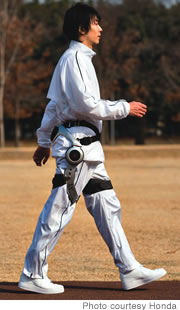UH’s Award-winning Mouse, Alfalfa

|
UH Engineering Team Wins Competition
Thanks to a robot micro-mouse named “Alfalfa,” two UH Manoa engineering students took first place in the Institute of Electrical and Electronics Engineers’ Region 6 Central Area Spring Meeting and Micromouse Competition, held a of couple months ago at the University of California at Santa Cruz.
Team members Alex Zamora and Tyson Seto-Mook built the winning micromouse, which completed the competition maze in one hour, 11 minutes and 29 seconds - 2 minutes and 36 seconds ahead of another UH Manoa entry. From the nine mice entered, UH Manoa teams swept the top seven places in the maze competition, the top three positions in the packaging (construction and design) competition and first place in the student paper competition.
In the micromouse competition, student teams design and build an autonomous robot mouse that is controlled by a microprocessor and is no larger than 25 centimeters by 25 centimeters in size.
Each mouse is given 10 minutes to learn the fastest route though the maze from the starting point to the center square. Good job, guys!
Honda Demonstrated Walking Assist Devices
Along similar lines, American Honda Motor Co. Inc. demonstrated its prototype walking assist devices for the first time in the U.S. at the 2009 Society of Automotive Engineers (SAE) World Congress. These devices are intended to support walking for the elderly and are currently being tested in real-world conditions by individuals with weakened leg muscles.

|
Called the Stride Management Assist, it’s lightweight and wearable, designed for people with weak leg muscles who can still walk on their own. It obtains data about your walking motions from hip angle sensors. Based on the information collected, the CPU applies cooperative control and calculates the amount and timing of the assistance that needs to be provided. With the device’s help, your stride is lengthened and the walking pace regulated, making it easier to walk.
The Stride Management Assist’s compact design was achieved with flat, brushless motors and a control system developed by Honda. The belt worn around the hip and thigh was employed to help achieve its total light weight of about 6 pounds. As a result, it reduces the user’s load and can be fitted to different body shapes.
Also, the Bodyweight Support Assist is designed to help weakened leg muscles, but it also could be helpful during some physically demanding activities. It will support your bodyweight to reduce the load on your legs while going up and down stairs. The load on leg muscles and joints - hip, knees and ankles - is reduced. The device is built simply of a seat, frame and shoes. The contraption is easily attached to your body by putting on the special shoes and lifting the seat into position. A mechanism that directs the assisting force toward your center of gravity and the ability to control the assist force in concert with the movement of the legs make it able to provide natural assistance in various postures and motions.
Honda initially began research on walking devices in 1999. The cumulative study of human walking, along with research and development of technologies conducted for Honda’s advanced humanoid robot, ASIMO, made the current developments possible.
E-mail this story | Print this page | Comments (0) | Archive | RSS Comments (0) |
Most Recent Comment(s):





 Del.icio.us
Del.icio.us








